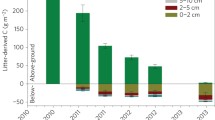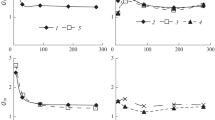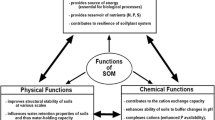Summary
In previous simple models describing decomposition of organic matter, the rate of decomposition was usually assumed to be constant. Experimental evidence has shown this is not true. The objective of this study was therefore to find a relationship between decomposition rate and time. This resulted in an equation (Eqn 5), that can be used for many types of organic materials, provided their ‘apparent initial age’ is known. This age is related to the humification coefficient and varies from 1 year for green matter to 14 years for some peats. Formulas to calculate accumulation and decomposition of ‘young’ soil organic matter were also derived.
It was demonstrated that apparent differences in soil organic matter quality, found after 25 years of different fertilizing practices, were related to the proportion of young soil organic matter.
Similar content being viewed by others
References
Dijk H van 1981 Some notes on the importance of mineralisation and immobilisation of nitrogen in making fertilizer recommendations. Colloque Humus-Azote Reims, 151–160.
Grootenhuis J A 1976 Excursiegids 1976 van de Drie Organische-Stof-Bedryven in de Noordoostpolder. Inst. Bodemvruchtbaarheid, Haren, the Netherlands, 17 p.
Henin S et Dupuis M 1945 Essai de bilan de la matière organique du sol. Ann. Agron. 15, 17–29.
Jenkinson, D S and Rayner J H 1977 The turnover of soil organic matter in some of the Rothamsted classical experiments. Soil Sci. 123, 298–305.
Kolenbrander G J 1969 De bepaling van de waarde van verschillende soorten organische stof ten aanzien van hun effect op het humusgehalte bij bouwland. Inst. Bodemvruchtbaarheid, Haren, the Netherlands, C 6988, 17 p.
Kolenbrander G J 1974 Efficiency of organic manure in increasing soil organic matter content. Trans. 10th Int. Congr. Soil Sci., vol. 2, 129–136.
Kortleven J 1963 Kwantitatieve aspecten van humusopbouw en humasafbraak. Versl. Landbouwk. Onderz. nr. 69.1, Wageningen, 109 p.
Sauerbeck D R and Gonzalez M A 1977 Field decomposition of carbon-14-labelled plant residues in various soils of the Federal Republic of Germany and Costa Rica. Soil Organic Matter Studies. Intern. Atomic Energy Agency, Vienna, vol. 1, 159–170.
Veen J A van and Paul E A 1981 Organic carbon dynamics in grassland soils. 1. Background information and computer simulation. Can. J. Soil Sci. 61, 185–201.
Verveda H W 1983 Opbouw en afbraak van jonge organische stof in de grond en de stikstofhuishouding onder een vierjarige vruchtwisseling met grasgroenbemester. Agric. Univ. Dept. Soil Science and Plant Nutrition, Wageningen. Internal Bulletin 58.
Author information
Authors and Affiliations
Rights and permissions
About this article
Cite this article
Janssen, B.H. A simple method for calculating decomposition and accumulation of ‘young’ soil organic matter. Plant Soil 76, 297–304 (1984). https://doi.org/10.1007/BF02205588
Issue Date:
DOI: https://doi.org/10.1007/BF02205588




